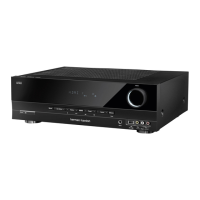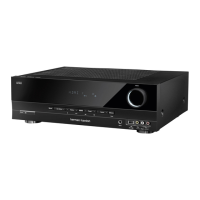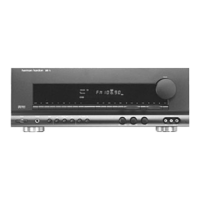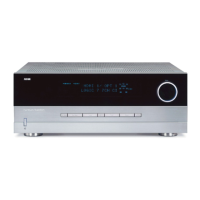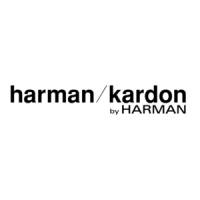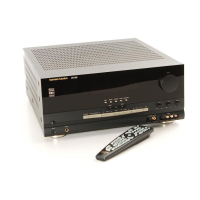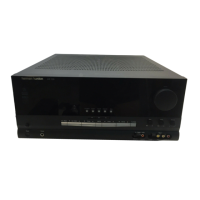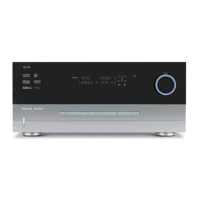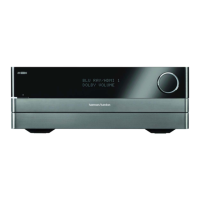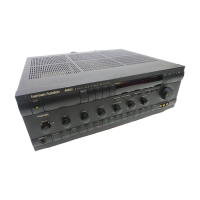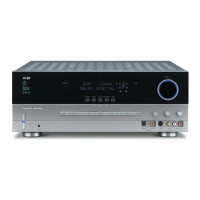30 OPERATION
Operation
Non-HDCD-compatible players are used (only a
digital output is needed).
When a CD with the HDCD logo is played, the
AVR 7000 is able to take advantage of the spe-
cial recording process that is used in the creation
of HDCD disc. The special circuitry enables audio
with extraordinary fidelity, stunning resolution
and the highest possible overall quality.
The AVR 7000 will automatically sense that it is
an HDCD recording and the HDCD indicator
A
will illuminate on the front panel to remind you
that an HDCD disc is playing.
It is important to note that the HDCD process is
completely compatible with standard recordings.
Indeed, the high-quality digital-to-analog
circuitry, that is part of HDCD and the HDCD
decoder chip, replacing the monolithic digital
filters used in conventional DACs, will enable
enhanced performance also with normal,
Non-HDCD encoded program material.
Selecting a Digital Source
To utilize either digital mode you must have
properly connected a digital source to the
AVR 7000. Connect the digital outputs from DVD
players, HDTV receivers, satellite systems or CD
players to the Optical or Coaxial inputs on the
rear panel
°·
. In order to provide a backup
signal and a source for analog stereo recording,
the analog outputs provided on digital source
equipment should also be connected to their
appropriate inputs on the AVR 7000 rear panel
(e.g., connect the analog stereo audio output
from a DVD to the DVD inputs
j
on the rear
panel when you connect the source’s digital out-
puts).
When playing a digital source such as DVD, first
select its analog input (DVD) using the remote or
front-panel controls to feed its video signal to
the TV monitor and to provide its analog audio
signal for recording. Next, select the digital input
connected with the DVD player by pressing the
Digital Input Selector button
A
and
then using the
⁄
/
¤
buttons
6
on the remote
or the Selector buttons
5
on the front panel to
choose either of the OPTICAL or COAXI-
ALinputs, as they appear in the Main
Information Display W or on screen display.
Press the Set button
8
(
to enter the
desired choice. Note, that a digital input (e.g.
coaxial) remains associated with any analog
input (e.g. DVD) as soon as it was selected, thus
the digital input needs not to be re-selected each
time the appropriate input choice (e.g. DVD) is
made.
Digital Status Indicators
When a digital source is playing, the AVR 7000
senses the type of bitstream data that is present.
Using this information, the correct surround
mode will automatically be selected. For exam-
ple, DTS bitstreams will cause the unit to switch
to DTS decoding, and Dolby Digital bitstreams
will enable Dolby Digital decoding. When the unit
senses PCM data, as is present from CDs and LDs
and some music DVDs, the unit will allow the
appropriate surround sources to be selected
manually. Since the range of available surround
modes depends on the type of digital data that is
present, the AVR 7000 uses a variety of indica-
tors to let you know what type of signal is pres-
ent. This will help you to understand the choice
of modes and the input channels recorded on the
disc.
When a digital source is playing, a Bitstream
Indicator
A
will light to show which type of
signal is playing:
AC-3: When the AC-3* indicator lights, a
Dolby Digital bitstream is being received.
Depending on the audio track selected on the
source player and number of channels on the
disc, different surround modes are possible. Note
that only one channel without subwoofer, called
”1.0” audio, or all five channels with subwoofer
(”5.1” audio) or all steps between can be record-
ed on digitally surround encoded audio tracks
(see NOTE below). With all those tracks, except
”2.0” audio, only the Dolby Digital and VMAx
modes are available. When the Dolby Digital sig-
nal is only two channel (”2.0”) these two chan-
nels (l and r) often contain Pro Logic surround
informations. With those tracks the AVR7000
automatically switches to the Pro Logic mode,
but you may turn Pro Logic off manually or you
may also select the Vmax mode.
DTS: When the DTS indicator lights, a DTS bit-
stream is being received. When the unit senses
this type of data, only the DTS mode may be
used.
PCM: When the PCM indicator lights, a stan-
dard Pulse Code Modulation, or PCM, signal is
being received. This is the type of digital audio
used by conventional compact disc and laser disc
recordings. When a PCM bitstream is present, all
modes except Dolby Digital and DTS are avail-
able. Note that the PCM signal format can be
selected on the DVD player with any audio track,
even with Dolby Digital tracks. So, if selected,
even ”2.0” D.D. audio tracks can be played with
all surround modes, also with the most effective
Logic 7.
HDCD: When the HDCD
®
indicator lights in
conjunction with the PCM indicator, the CD that
is playing is encoded through the special High
Definition Compatible Digital
®
process. HDCD
discs use 20-bit encoding and other proprietary
processing to provide the ultimate in CD listening
(see page 29). Note that HDCD processing is only
available in the Stereo or Surround Off mode.
In addition to the bitstream indicators, the AVR
7000 features a set of unique channel input indi-
cators that tell you how many channels of digital
information are being received and if the digital
signal is interrupted.
These indicators are the L/C/R/LS/RS/LFE letters
that are inside the center boxes of the
Speaker/Channel Input Indicators
P
in the front
panel Information Display
Ò
. When a stan-
dard analog stereo or matrix surround signal is in
use, only the “L” and “R” indicators will light, as
analog signals have only left and right channels,
respectively, even surround recordings, carrying
surround information on the left and right chan-
nels only.
Digital signals, however, may have one to six sep-
arate channels, depending on the program mate-
rial, the method of transmission and the way in
which it was encoded.When a digital signal is
playing, the letters in these indicators will light in
response to the specific signal being received. It
is important to note that although Dolby Digital,
for example, is referred to as a “5.1” system, not
all Dolby Digital DVD or audio tracks selected on
DVD or other Dolby Digital programs are encod-
ed for 5.1. Thus, it is sometimes normal for a
DVD with a Dolby Digital soundtrack to trigger
only the “L” and “R” indicators.
NOTE: Many DVD discs are recorded with both
“5.1” and “2.0” versions of the same sound-
track, the ”2.0” version often is used with other
languages. When playing a DVD, always be cer-
tain to check the type of material on the disc.
Most discs show this information in the form of a
listing or icon on the back of the disc jacket.
When a disc does offer multiple soundtrack
choices you may have to make some adjustments
to your DVD player (usually with the “Audio
Select” button or in a menu screen on the disc)
to send a full 5.1 feed to the AVR 7000 or to
select the appropriate audio track and thus lan-
guage (”2.0” audio tracks can be played with all
surround modes, even with Logic 7, see indicator
”PCM” left on that page). It is also possible for
the type of signal feed to change during the
course of a DVD playback. In some cases the pre-
views of special material will only be recorded in
2.0 audio, while the main feature is available in
5.1 audio. As long as your DVD player is set for
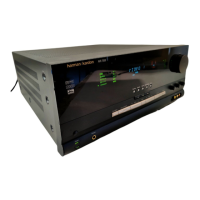
